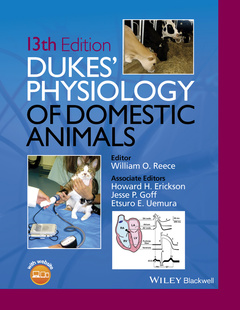Description
Dukes′ Physiology of Domestic Animals (13th Ed.)
Coordinator: Reece William O.
Language: English
Subjects for Dukes′ Physiology of Domestic Animals:
760 p. · 21.9x28.4 cm · Hardback
Description
/li>Contents
/li>Biography
/li>
This fully revised new edition of the classic reference on domestic
animal physiology provides detailed descriptions of animal function and
dysfunction, with an emphasis on clinical relevance and pedagogical
features to enhance learning.
• Presents in–depth, comprehensive
descriptions of domestic animal function and dysfunction
• Emphasizes
clinical relevance, with clinical correlations, notes of relevance, and
self–assessment questions featuring situations likely to be faced in
practice
• Offers pedagogical features, including chapter outlines
and introductions, key terms throughout the book, additional images,
questions to enhance learning, and self–assessment exercises
•
Distills the most useful information for ease of use, with improved
continuity and reduced repetition
• Includes a companion website
offering review questions and answers and the figures from the book in
PowerPoint.
William O. Reece, DVM, PhD, is University Professor Emeritus in the Department of Biomedical Sciences, College of Veterinary Medicine, Iowa State University, Ames, Iowa, USA.
Howard Erickson, DVM, PhD, is Professor Emeritus of Physiology in the Department of Anatomy and Physiology, College of Veterinary Medicine, Kansas State University, Manhattan, Kansas, USA.
Jesse P. Goff, DVM, PhD, is Professor and Anderson Chair in the Department of Biomedical Sciences, Iowa State University, College of Veterinary Medicine, Ames, Iowa, USA.
Etsuro E. Uemura, DVM, MS, PhD, is Professor in the Department of Biomedical Sciences, College of Veterinary Medicine, Iowa State University, Ames, Iowa, USA.




